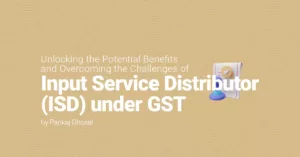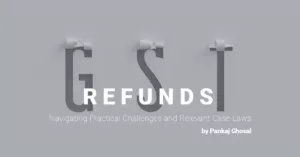The Hon’ble Finance Minister, Ms. Nirmala Sitharaman, presented her first budget on 5th July 2019, introducing various measures in the Indian tax regime to get the same in lines with Indian Government’s policy of ease of doing business in India.
Through this article, we wish to discuss the transfer pricing proposals for Multinational Enterprises (“MNEs”).
A. Secondary Adjustment
The most important clarification provided in this Budget is the proposed amendment to the secondary adjustment provisions. To understand the proposed amendment, it is important we discuss in brief about the backdrop of the existing provision:
Background
India introduced secondary adjustment in its transfer pricing regulations vide the Finance Act, 2017. The secondary adjustment is required where a primary adjustment is made to the transfer price in one of the following circumstances:
- Voluntarily made by the taxpayer in the tax return
- Made by the tax officer and accepted by the taxpayer
- Determined by an Advance Pricing Agreement (APA) entered into by the taxpayer
- Made as per the safe harbor rules
- Resulted from a Mutual Agreement Procedure (MAP) resolution
As per the existing provisions, the primary adjustment, if not repatriated to India within 90 days, shall be deemed to be an advance made by the taxpayer to such associated enterprise (AE). Accordingly, the provision adopted the scheme of imputing interest on the amount of primary adjustment imposed upon the taxpayer. In case the amount of primary adjustment would never be repatriated in favour of the taxpayer, then the imputation of interest would have run till perpetuity.
The rate of interest was fixed at six-month LIBOR plus three hundred basis points, in case the international transaction was denominated in foreign currency, and rate of one-year marginal cost of lending of State Bank of India plus three hundred twenty-five basis points in other cases was prescribed.
The Practical Difficulty Faced By The Taxpayer companies
The companies have been facing difficulty in understanding and solving the loop of payment of tax on imputed interest till perpetuity. The companies were trying to find clarity regarding the following questions:
- Practical issues of how to get money repatriated
- What documentation to maintain for the same?
- What are the TP issues that foreign AE will face in their home country?
- What issues will the company face in GST, FEMA and even taxation laws of India, etc.?
Proposed Amendment
The Finance (No. 2) Bill, 2019 has made a slightly costly attempt to address the aforesaid practical difficulties by proposing an alternative to the taxpayers to pay a “one-time” and final income tax. The final tax will definitely prove to be a costlier option to the Indian company at a tax rate of 18% and a surcharge of 12% and cess thereon, on the amount of primary adjustment.
Thus, going forward, taxpayers facing primary adjustments would need to choose the option of either paying tax @ 30% on interest on notional loan until the amount of principal adjustment is repatriated, or pay the one time and final tax thereon @ 18% plus surcharge of 12%.
It is to be noted that no credit or deduction shall be allowed against such one-time payment of tax.
Further, following other clarificatory amendments have been introduced with respect to the secondary adjustment provisions, with effect from AY 2018-19 and subsequent years:
- For the ease of international groups and global regulations, the proposed amendment clarified that such adjustment amount may be repatriated from any of the AEs of the taxpayer which is not resident in India
- Primary adjustments determined under APAs signed prior to 1st April 2017 have now been excluded from the ambit of Section 92CE. However, no refund of taxes already paid till date under the pre-amended section would be allowed
- The existing dual conditions for non-applicability of secondary adjustments have been made alternative to each other:
(a) primary adjustment does not exceed INR 1 crore; or
(b) primary adjustments made on or before AY 2016-17
The said amendment though called as clarificatory has brought in a sigh of relief, albeit a costly one for the Indian companies stuck in the circle of payment of taxes on perpetual imputed interest on deemed loan of outstanding primary adjustment. However, we feel that the Indian government has taken step in right direction to match the global standards when it comes to Transfer Pricing regulations.
B . Proposed Clarificatory Amendments Regarding Review Of Modified Return Under Advance Pricing Agreement (APA)
APA, being a mechanism covering 5 forward years and 4 roll-back years has rules regarding furnishing of modified return post signing of the APA. A modified return is filed for the years where the original return was filed prior to signing of the APA but due to the final agreement of APA, there arises a need to revise the total income being offered to tax post APA sign off.
Considering the existing language of the provisions of Section 92CD of the Act, i.e., ‘assess or reassess or recompute’ existed, it led to apprehension regarding a situation where an AO may start fresh proceedings of previously closed proceedings.
To give peace of mind to the taxpayer and more clarity to bring in the intent of legislation, the Bill proposed to clarify that the powers of the AO would be restricted only to the modified portion of the total income pursuant to and in accordance with the APA.
This is certainly a welcome clarification which otherwise was and could have resulted in additional litigation process, contrary to the basic intent of the APA program.
C. Clarification on “Accounting Year” for Country-by-Country Report (CbCR) for Alternate Reporting Entity (ARE)
Earlier, there was confusion regarding which accounting year is required to be considered where there was an ARE resident in India. There was no logical answer for whether the Indian financial year or ultimate parent accounting year were to be considered for ARE in India.
Considering the above dilemma, the Bill proposed amendment in Section 286 of the Act, to delete ARE in the sub-clause (i) of clause (a) of the section 286(9) of the Act. The said amendment led to a clear stand of considering accounting year of the Parent entity even if the ARE is resident in India.
The amendment being clarificatory in nature, will take effect retrospectively from the 1st April 2017 and will, accordingly, apply in relation to the Assessment Year 2017-18 and the subsequent assessment years.
D. Reporting compliance w.r.t Master File (Form 3CEAA) for constituent entity (CE) in India
The Finance Bill 2019 proposed a revision in the entire Section 92D of the Act i.e., maintaining documentation under local and master file in relation to international transaction. The proposed amendment attempts to include certain reporting for companies being CE of international group but not having any international transaction during the year.
The said amendment will now require all the CEs in India, whether or not having international transaction during the year to maintain and provide documentation under Rule 10DA of the Income Tax Rules, 1962 (known as Part A compliance under Form 3CEAA).
This again is a clarificatory change since the existing regulations had elements of adopting a contrary position.
The Finance Bill 2019, with respect to, Transfer Pricing regulations in India made an effort to bring clarity to the taxpayer and streamline the Indian provisions in lines with the global practices. It is definitely a welcome move by Modi Government 2.0.
Having said that, for future, we look forward to having language of the tax laws clearly highlighting the intent of the legislation and reducing the unnecessary confusion and litigations and being completely in lines with global practices.










